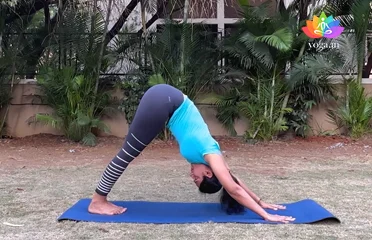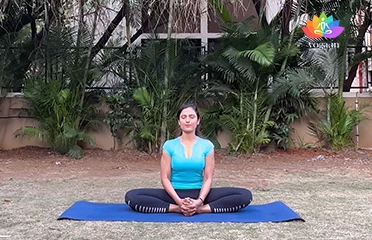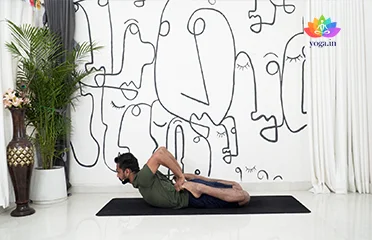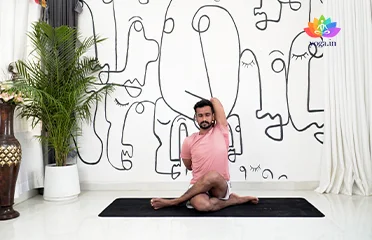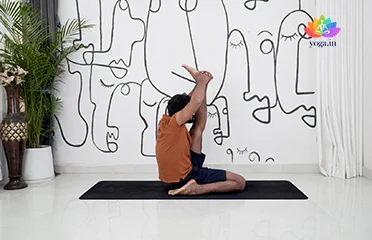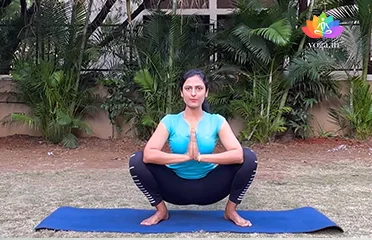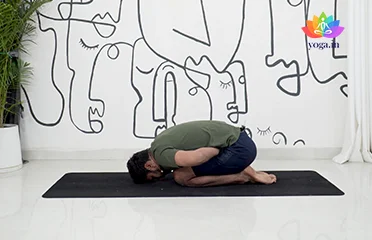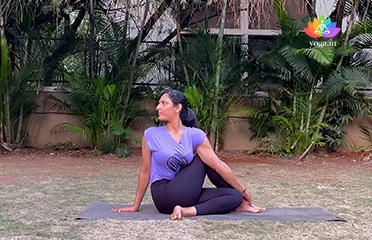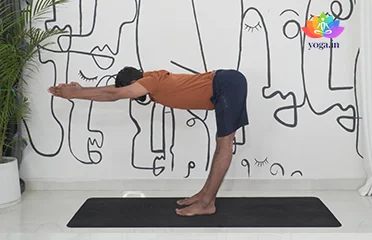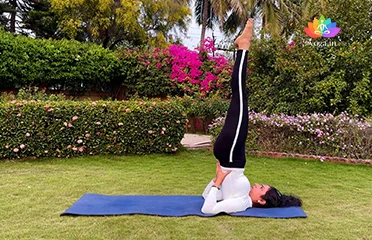Adho Mukha Svanasana (Downward-Facing Do
अधोमुख श्वानासन / Downward-Facing Dog Pose
The sanskrit name is derived from adhas (अधस्) meaning down, mukha [�K]
Bhadrasana (Gracious Pose | Butterfly Po
भद्रासन / Gracious Pose | Butterfly Pose
The Sanskrit name is derived from Bhadra (भद्रा) meaning gracious, [�K]
Bhekasana (Frog Pose II)
भेकासन / Frog Pose II
The Sanskrit name is derived from Bheka (भेका) meaning frog and asana [�K]
Gomukhasana (Cow Face Pose)
गोमुखासन / Cow Face Pose
The Sanskrit name is derived from Gau (गो) meaning cow, Mukh meaning face [�K]
Kraunchasana (Heron Pose)
क्रौञ्चासन / Heron Pose
The Sanskrit name is derived from Kraunch (क्रौञ्च) meaning heron [�K]
Malasana (Garland Pose)
मालासना / Garland Pose
The Sanskrit name is derived from Mala (माला) means garland or rosary [�K]
Mandukasana (Frog Pose)
मण्डुकासन / Frog Pose
The Sanskrit name is derived from Manduka (मण्डुका) meaning frog [�K]
Matsyendrasana (Lord of the Fishes Pose)
मत्स्येन्द्रासन / Lord of the Fishes Pose
The name Matsyendrasana is derived from the Sanskrit words Matsya (मत्स्य) [�K]
Samakonasana (The Right-Angle Posture)
समकोणासन / The Right-Angle Posture
The Sanskrit name is derived from Sama (समा) meaning straight, Kona meaning [�K]
Sarvangasana (Shoulderstand)
सर्वाङ्गासनI / Shoulderstand
The Sanskrit name is derived from Sarva (सर्वाङ्ग) meaning all, [�K]
- 1
- 2
How Yoga Can Help Cure Heels Pain or Spurs:
Heel pain or heel spurs are common conditions that cause discomfort and pain in the heel area. Yoga can be an effective treatment for heel pain by improving flexibility, reducing inflammation, and strengthening the muscles around the heel. Regular practice of specific yoga postures and techniques can alleviate pain, enhance mobility, and promote overall foot health.
Understanding Heel Pain or Spurs:
Heel pain often refers to discomfort under or behind the heel. Heel spurs are bony growths that develop on the underside of the heel bone. They can be caused by repetitive strain on the foot muscles and ligaments. Conditions like plantar fasciitis, Achilles tendinitis, and bursitis can contribute to heel pain and the formation of heel spurs, leading to persistent pain and difficulty in walking.
Yoga’s Role in Relieving Heel Pain or Spurs:
Yoga can significantly relieve heel pain and spurs through gentle stretching and strengthening exercises. Specific yoga poses can help by:
- Stretching the plantar fascia and Achilles tendon.
- Strengthening the muscles of the foot and lower leg.
- Improving blood circulation to the affected area.
- Reducing inflammation and promoting healing.
Key Factors Contributing to Heel Pain or Spurs:
Several factors can contribute to the development of heel pain or spurs, including:
- Overuse: Repetitive strain from activities like running or jumping.
- Improper Footwear: Wearing shoes that lack proper support or cushioning.
- Obesity: Excess weight puts additional stress on the heel.
- Flat Feet or High Arches: Abnormal foot mechanics can lead to heel pain.
- Age: The risk increases with age due to wear and tear on the heel.
Symptoms of Heel Pain or Spurs:
Common symptoms of heel pain or spurs include:
- Sharp Pain: Intense, stabbing pain under the heel, especially when taking the first steps in the morning.
- Tenderness: Sensitivity to touch or pressure on the heel.
- Swelling: Inflammation and swelling around the heel area.
- Heat: Warmth in the affected area due to inflammation.
- Difficulty Walking: Pain that makes walking or standing for long periods challenging.
- Bone Spur: A visible or palpable bony protrusion under the heel.
Treatment of Heel Pain or Spurs through Yoga and Pranayama:
Yoga and pranayama can be highly beneficial in managing heel pain or spurs. Some effective practices include:
Specific Yoga Poses:
- Adho Mukha Svanasana (Downward-Facing Dog Pose): Stretches the calves, Achilles tendon, and plantar fascia.
- Virasana (Hero Pose): Stretches the feet and improves circulation.
- Supta Padangusthasana (Reclining Hand-to-Big-Toe Pose): Stretches the hamstrings and calves.
Pranayama Exercises:
- Ujjayi Breathing (Victorious Breath): Promotes relaxation and reduces stress.
Diet for Heel Pain or Spurs:
A balanced diet can help manage heel pain or spurs. Recommendations include:
- Anti-Inflammatory Foods: Consume foods rich in omega-3 fatty acids, like salmon, walnuts, and flaxseeds.
- Calcium-Rich Foods: Include dairy products, leafy greens, and fortified foods to support bone health.
- Vitamin C: Citrus fruits, bell peppers, and strawberries help with tissue repair.
- Hydration: Drink plenty of water to maintain overall health and support healing.
Caution for Heel Pain or Spurs:
While practicing yoga for heel pain or spurs, it is essential to:
- Avoid Overexertion: Practice at a gentle pace to prevent further strain on the heel.
- Be Mindful of Pain: Stop immediately if any pose causes discomfort or aggravates the pain.
Always consult with a healthcare provider before starting any new exercise regimen, especially if you have severe heel pain or spurs.
Contraindications for Heel Pain or Spurs:
Individuals with severe heel pain or significant inflammation should:
- Avoid High-Impact Yoga Practices: Vigorous exercises might exacerbate symptoms.
- Steer Clear of Certain Poses: Inversions and poses that put pressure on the heel may increase discomfort.
- Seek Professional Guidance: Consult a yoga therapist or healthcare professional for personalized recommendations.


